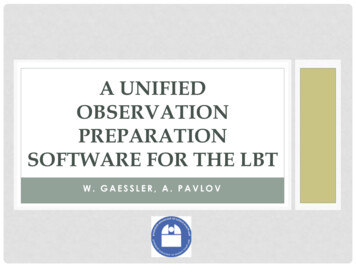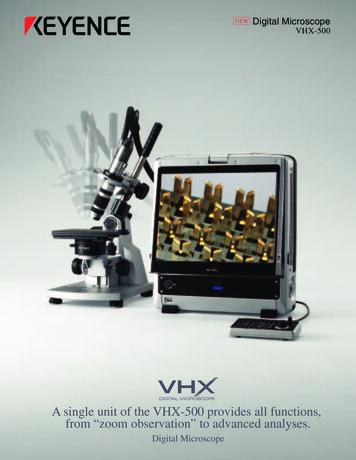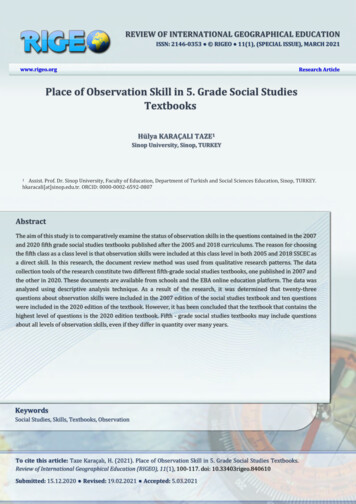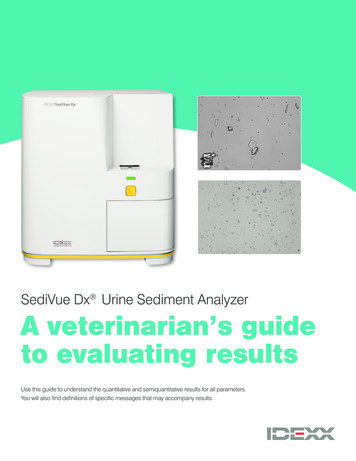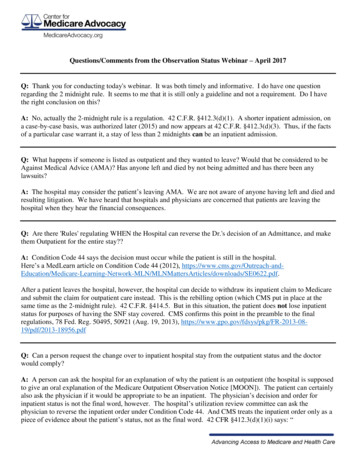
Transcription
Questions/Comments from the Observation Status Webinar – April 2017Q: Thank you for conducting today's webinar. It was both timely and informative. I do have one questionregarding the 2 midnight rule. It seems to me that it is still only a guideline and not a requirement. Do I havethe right conclusion on this?A: No, actually the 2-midnight rule is a regulation. 42 C.F.R. §412.3(d)(1). A shorter inpatient admission, ona case-by-case basis, was authorized later (2015) and now appears at 42 C.F.R. §412.3(d)(3). Thus, if the factsof a particular case warrant it, a stay of less than 2 midnights can be an inpatient admission.Q: What happens if someone is listed as outpatient and they wanted to leave? Would that be considered to beAgainst Medical Advice (AMA)? Has anyone left and died by not being admitted and has there been anylawsuits?A: The hospital may consider the patient’s leaving AMA. We are not aware of anyone having left and died andresulting litigation. We have heard that hospitals and physicians are concerned that patients are leaving thehospital when they hear the financial consequences.Q: Are there 'Rules' regulating WHEN the Hospital can reverse the Dr.'s decision of an Admittance, and makethem Outpatient for the entire stay?A: Condition Code 44 says the decision must occur while the patient is still in the hospital.Here’s a MedLearn article on Condition Code 44 (2012), /SE0622.pdf.After a patient leaves the hospital, however, the hospital can decide to withdraw its inpatient claim to Medicareand submit the claim for outpatient care instead. This is the rebilling option (which CMS put in place at thesame time as the 2-midnight rule). 42 C.F.R. §414.5. But in this situation, the patient does not lose inpatientstatus for purposes of having the SNF stay covered. CMS confirms this point in the preamble to the finalregulations, 78 Fed. Reg. 50495, 50921 (Aug. 19, 2013), 3-18956.pdfQ: Can a person request the change over to inpatient hospital stay from the outpatient status and the doctorwould comply?A: A person can ask the hospital for an explanation of why the patient is an outpatient (the hospital is supposedto give an oral explanation of the Medicare Outpatient Observation Notice [MOON]). The patient can certainlyalso ask the physician if it would be appropriate to be an inpatient. The physician’s decision and order forinpatient status is not the final word, however. The hospital’s utilization review committee can ask thephysician to reverse the inpatient order under Condition Code 44. And CMS treats the inpatient order only as apiece of evidence about the patient’s status, not as the final word. 42 CFR §412.3(d)(1)(i) says: “
(i) The expectation of the physician should be based on such complex medical factors as patient historyand comorbidities, the severity of signs and symptoms, current medical needs, and the risk of an adverseevent. The factors that lead to a particular clinical expectation must be documented in the medical recordin order to be granted consideration.”The preamble to the final rules discusses physician orders and their significance. 78 Fed. Reg. 50495, 50938(Aug. 19, 2013), 13-18956.pdf. for example, at p.50944, “Satisfying the requirements regarding the physician order and certification alone does not guaranteeMedicare payment. Rather, in order for payment to be provided under Medicare Part A, the care must also be‘‘reasonable and necessary,’’ as specified under section 1862(a)(1) of the Act.”Q: Could the person (typically a family member or friend) identified by the hospital as a potential recipient ofthe MOON refuse the notice?A: If the person refuses the notice, the hospital staff person will record the refusal. MOON Instructions,Medicare Claims Processing Manual, Chapter 30, section 400.3.5, ��400.3.5- Refusal to Sign the MOON (Rev.3695, Issued: 01-20-17, Effective: 02-21-17, Implementation: 02-21-17)If the beneficiary refuses to sign the MOON, and there is no representative to sign on behalf of the beneficiary, thenotice must be signed by the staff member of the hospital or CAH who presented the written notification. The staffmember’s signature must include the name and title of the staff member, a certification that the notification waspresented, and the date and time the notification was presented. The staff member annotates the “AdditionalInformation” section of the MOON to include the staff member’s signature and certification of delivery. The dateand time of refusal is considered to be the date of notice receipt.”Q: How long does a facility have to change the observation status from inpatient to observation. Can this flipback and forth?A: The hospital must make the switch from inpatient to observation while the patient is still in the hospital andgive notice to the patient, under Condition Code 44. The hospital can change the patient’s status, for purposesof its claim to Medicare, under the rebilling option.The status can flip back and forth and sometimes does. Hospitals may consult with Executive HealthResources, a private company with physicians across the country consulting with hospitals on their patients’status, http://www.ehrdocs.com/. We’ve seen instances where the EHR doctor one day makes onerecommendation to the hospital about a patient’s status and the next day, a different EHR doctor makes adifferent recommendation.Q: Since a patient cannot challenge outpatient status, they can leave the hospital, even if against medical advice- And Medicare would cover the outpatient status?A: It seems that Medicare would cover the outpatient status, unless there is a rule that says a hospital can’t billMedicare if a patient leaves against medical advice. The patient would be billed the Part B copayments,presumably.2
Q: I worked with a man who experienced his hospital status become retroactive to observation by a utilizationreview team soon before his discharge from a hospital to a SNF. Can you discuss advocacy efforts for CMS toreview that particular rule and maybe change it?A: This would certainly be fair and equitable. Curently we don’t have any advocacy efforts directed towardsthe particular hospital practice of retroactively changing a patient’s status from inpatient to outpatient. Butadvocacy efforts include: (1) supporting the legislation to count all time in the hospital, for purposes of thethree-day inpatient requirements (H.R. 1421/ S.568, the Improving Access to Medicare Coverage Act of 2017);(2) drafting a legal memorandum arguing that CMS has authority under existing law to count all time in thehospital; (3) filing litigation, Barrows, to get notice and Due Process rights for patients who are calledoutpatients; (4) getting as much media coverage as possible; (5) collecting stories from beneficiaries and theirfamilies, ation-status-story; and (6) supporting apetition (joint effort with the National Committee to Preserve Social Security and iZSeOYjMqFFA2Q: If in observation and then go to in-patient rehab, will 3 days there (rehab) count as in-patient admission?A: If, by “inpatient rehab” you mean an inpatient rehabilitation hospital (also known as inpatient rehabilitationfacility), because that care is considered by Medicare to be hospital inpatient care, then the time in the IRH/IRFwould count as inpatient hospital time, if the patient then went to a SNF.Q: If the notice is not given, is the consequence that liability for the cost of the care is shifted to the provider oris the notice essentially meaningless?A: The NOTICE Act does not include any explicit consequence to the hospital of failing to give notice (andthat answer is also true for the state laws we’ve read as well). But it’s worth filing a complaint with the statedepartment of health. A daughter we spoke to had her complaint substantiated (although she could notremember what the complaint was about, nor did the letter from the state say what complaint it wassubstantiating) and was then called by the hospital, which told her to come pick up a check for her mother’snursing home care. The hospital essentially picked up the SNF’s charges.Q: Why was observation status implemented by Medicare in the first place?A: Observation status was initially created by hospitals when the prospective payment system (diagnosisrelated groups, DRGs) went into effect decades ago. Hospitals wanted to get an additional source of payment –outpatient observation, followed by an inpatient (DRG-based) payment. The Federal Government put a stop tothat practice by saying that the outpatient days were bundled into the inpatient stay and paid only by the DRG.We really began hearing about extensive use of observation status (and other outpatient status) when theRecovery Auditor Contractor program (RAC, now just Recovery Auditors) began doing reviews. If the RACdecided that a hospital should have billed a patient as outpatient, not inpatient, the hospital had to give virtuallyALL of the Medicare reimbursement back to Medicare – even though the care was medically necessary andappropriate. Hospitals didn’t like the hassle of the RAC reviews, which looked at large numbers of records andwent back years (and cost a lot of money. A Johns Hopkins University representative testified at aCongressional hearing in 2014 that the hospital spent 2 million just getting ready for the RAC program to gointo effect). So hospitals thought it would be better to get the lower Part B payments than risk RAC review andthe possibility of nothing.3
Some hospitals are still appealing these inpatient/outpatient claims. As many as about half the 700,000-800,000appeals awaiting review by Administrative Law Judge hearings are hospitals appealing inpatient denials.Q: If this policy is obviously so financially hurtful to Medicare beneficiaries, why isn't it being corrected?A: Observation status saves Medicare money. Medicare is generally paying hospitals less (outpatient is usuallycheaper than inpatient) and it’s not paying for SNF care for lots of people.The legislation to fix the problem has been introduced in Congress, now for the fourth time. It hasn’t passed(even though there is an ad hoc coalition of 32 national organizations supporting the legislation and there is NOopposition) because (1) Bills need “scores” from the Congressional Budget Office (CBO) (A score is supposedto identify the cost of legislation; Congress requires bills to be paid for [i.e., take the money from someplaceelse] unless it decides to pass a bill without a score) and there is no score for this legislation; (2) Bills generallyneed some legislative “vehicle” to attach to. We don’t have too many free-standing bills passed. Generally,legislation that needs to get enacted gets lots of other bills and ideas attached. The observation status bill couldget attached to some other legislation if it had a low CBO score.Q: I’m under the impression that part of the rationale for reduction in inpatient status has to do with keyperformance indicators for hospital quality of care relative to "readmission." Is this true?A: The readmission penalty is another, more recent, incentive for hospitals to call patients outpatients. Thereadmission penalty applies only if a patient is an inpatient and then readmitted as an inpatient within 30 days(for certain medical issues, at this point). If either stay in the hospital is observation/outpatient, then thereadmission penalty does not apply. But it seems the main rationale for observation status is RAC audits.Hospitals talk about “fraud” for calling patients inpatients. “Fraud” is not related to readmission penalties.Q: Is there any kind of penalty if the patient dies?A: There’s no regulatory penalty.Q: So if the services are pulled apart, ie: hospital bed, doctors, tests, meds, is it safe to say that the Part Bcoverage would only pay for the doctors’ fees?A: If a patient is in observation/outpatient, whatever tests, services, therapies, etc. the hospital bills is Part B,except that it also bills patients for medications and patients need to pay for the medications out-of-pocket.Patients can request that their Part D plans pay for the medications as an out-of-network pharmacy. Here’s aCMA Alert about contacting the Part D plan, e-hospital-during-an-observation-status-stay/Q: So is the 2 midnight rule really only a guideline? Does the patient have any recourse with the hospital ifthey do not get a MOON?A: The 2-midnight rule is a regulation, not just a guideline, but CMS also allows, on a case-by-case basis, 1midnight inpatient stays. The 2-midnight rule is enforced by CMS through reviews on inpatient stays, reviewsby Quality Improvement Organizations and reviews by Recovery Auditors.4
The NOTICE Act does not give patients any specific recourse if the hospital doesn’t give the moon. Asdiscussed above, filing a complaint with the state health department might be an appropriate response and mightget a result.Q: What is the difference in the payment between an outpatient and an observation outpatient?A: We believe that observation means that the hospital billed Medicare for observation hours (or what it maycall observation services). If the hospital doesn’t bill Medicare for observation hours, the patient may simply bean outpatient. The Inspector General’s first report on observation indicated that about half the patients arespecifically observation and half are outpatients. Here’s a CMA Alert on the report, with a link to the IG’sreport. lations/5
A: The hospital must make the switch from inpatient to observation while the patient is still in the hospital and give notice to the patient, under Condition Code 44. The hospital can change the patient's status, for purposes of its claim to Medicare, under the rebilling option. The status can flip back and forth and sometimes does.





